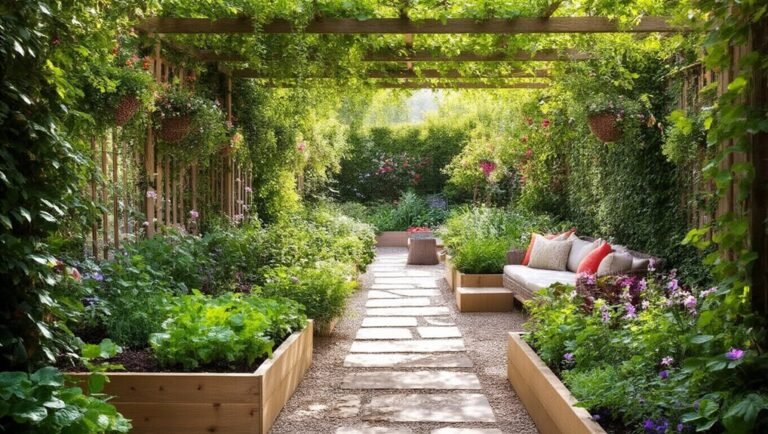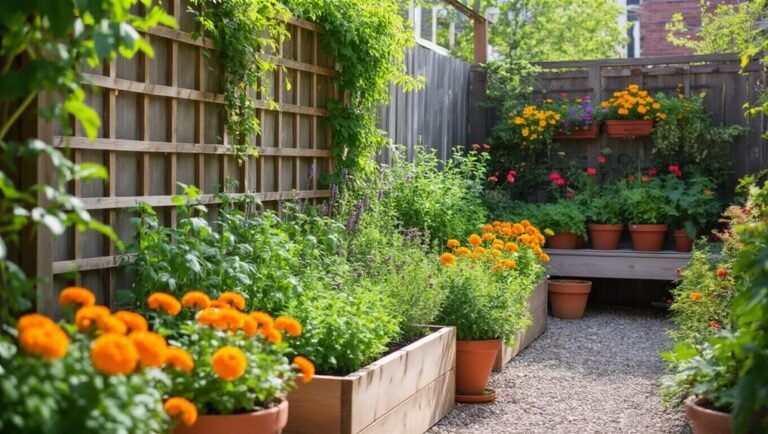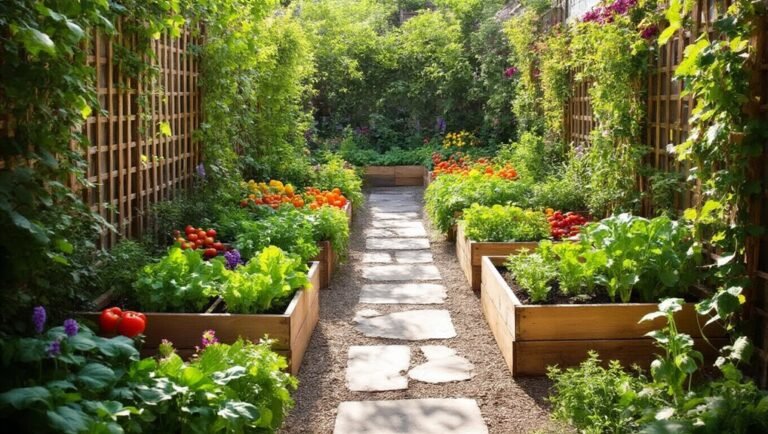To grow onions from scraps, start by selecting healthy onions with green shoots. Cut the bulbs, leaving an inch of the root end. Rinse them, let them dry, then plant in well-drained soil, about an inch deep and spaced a few inches apart. Ensure they get plenty of sunlight and water regularly without over-soaking. After a few weeks, you’ll be ready to harvest. Want to learn about caring for your onions and harvesting tips?
Key Takeaways
- Select healthy onion scraps, leaving an inch of the root end intact for successful regrowth.
- Rinse scraps to remove dirt, then let them dry to prevent rot before planting.
- Plant scraps in well-draining soil, about an inch deep, ensuring they are spaced a few inches apart.
- Water regularly, keeping the soil moist and providing at least six hours of sunlight daily.
- Harvest onions gently once mature, cure them in a shaded spot, and store in a cool, dark place.
Choosing the Right Onions for Regrowing
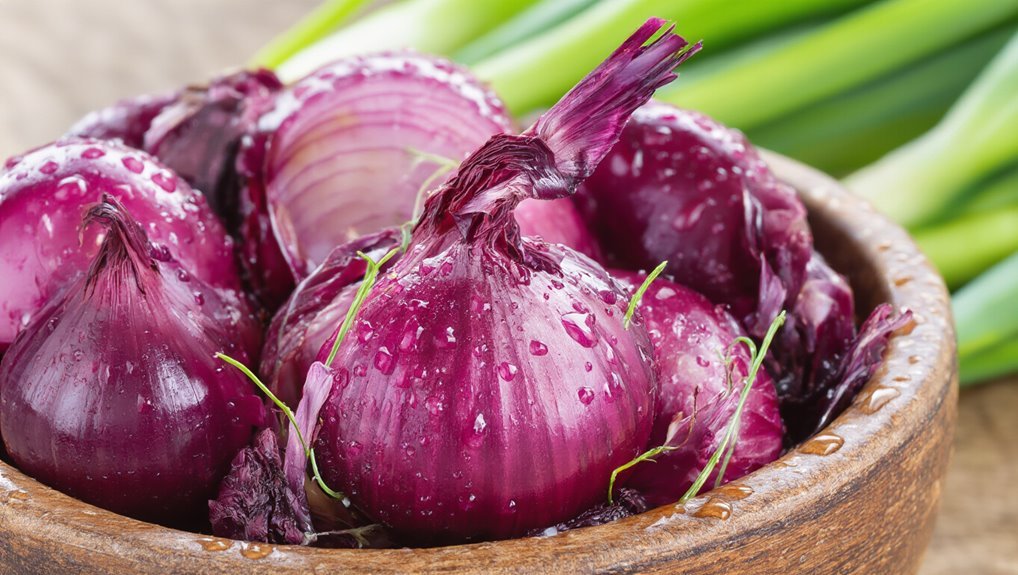
When you want to regrow onions, choosing the right ones is crucial for success. Start by selecting healthy, firm onions. Avoid any that show signs of decay or mold.
Look for onions with vibrant green shoots, as these indicate vitality. You should also consider the variety; yellow and red onions are commonly used for regrowing, but green onions can be particularly easy and fast. For best results, use quality gardening tools to prepare your soil and ensure even watering.
If you’re using store-bought onions, ensure they haven’t been treated with growth inhibitors. Organic onions are often a safer choice.
For gardeners interested in natural pest control, you might also want to explore insect repellent plants that can be grown alongside your onions to help keep pests at bay.
Preparing Onion Scraps for Planting
To successfully regrow onions from scraps, start by cutting the bulbs properly. Make sure you leave about an inch of the root end intact. This will help the onion sprout new growth.
After cutting, rinse the scraps under cold water to remove any dirt or residue. For even greater ease and consistency, consider using self-watering planters to help maintain the right moisture level for your onion scraps as they develop.
Next, let the onion scraps dry for a few hours on a paper towel. This helps prevent rot when you plant them. Keep the scraps in a cool, dry place until you’re ready to plant.
If you want to give your onion scraps the best chance at thriving, consider using seed starting kits for improved germination and healthy early growth.
Here are some key tips:
- Use healthy, fresh onion scraps.
- Avoid using scraps from spoiled onions.
- Label your scraps if you’re using different varieties.
- Monitor the scraps for any signs of mold.
- Be patient; growth takes time!
Planting Your Onion Scraps
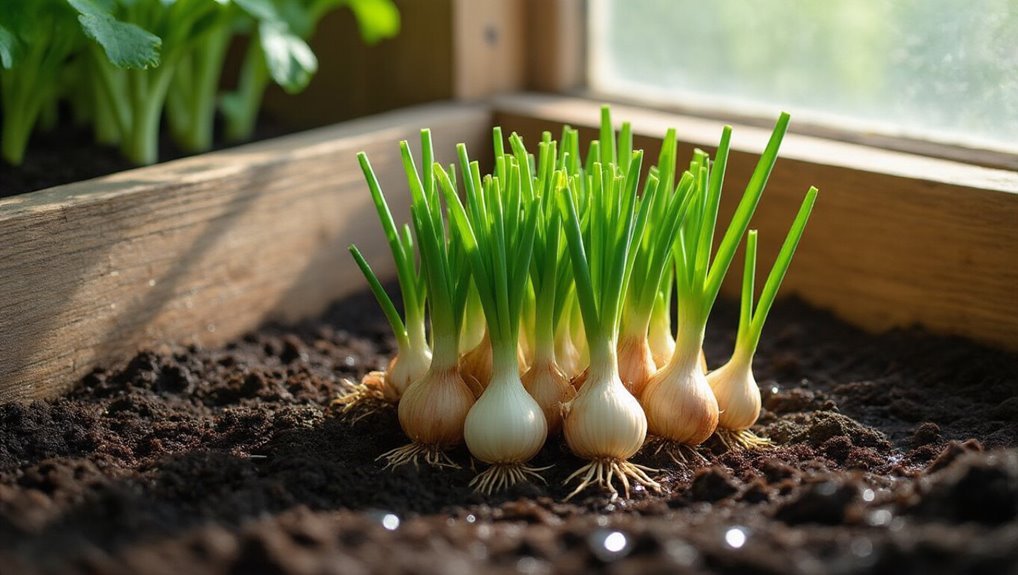
Planting your onion scraps is an exciting step that can lead to a bountiful harvest. Start by choosing a sunny spot in your garden or a suitable container with good drainage.
Make sure the soil is rich and well-aerated. Dig small holes, about an inch deep, and place the cut side of the onion scrap down. Space them a few inches apart to allow for growth. For gardeners looking to make the most of their efforts, using compost tumblers can efficiently turn kitchen and yard waste into valuable organic material for your soil.
After planting, gently cover the scraps with soil, ensuring they’re snug but not buried too deep. Water them lightly to keep the soil moist but not soggy.
Keep an eye on the weather, as protecting them from harsh conditions will promote strong growth. Soon, you’ll see green shoots emerging, signaling your onions are on their way!
To help your onion scraps thrive, consider enriching your soil using compost bins to create nutrient-rich compost for your garden.
Caring for Your Growing Onions
Caring for your growing onions is crucial to ensure they thrive and produce a good harvest.
Start by providing them with adequate sunlight—at least six hours a day. Water them regularly, but avoid overwatering; the soil should be moist but not soggy.
Keep an eye out for pests and diseases, removing any affected plants promptly. Maintain a weed-free environment to reduce competition for nutrients. You can also boost growth by using Plant Fertilizer Tablets, which offer a convenient and effective way to supply essential nutrients directly to your onion plants.
Lastly, consider fertilizing them every few weeks with a balanced fertilizer to support their growth.
For the healthiest onions, nourish your plants with the best plant food options to provide them with essential nutrients throughout their growing cycle.
- Ensure they get plenty of sunlight
- Water consistently, without overdoing it
- Monitor for pests and diseases
- Keep the area weed-free
- Fertilize every few weeks for optimal growth
Harvesting and Using Your Homegrown Onions
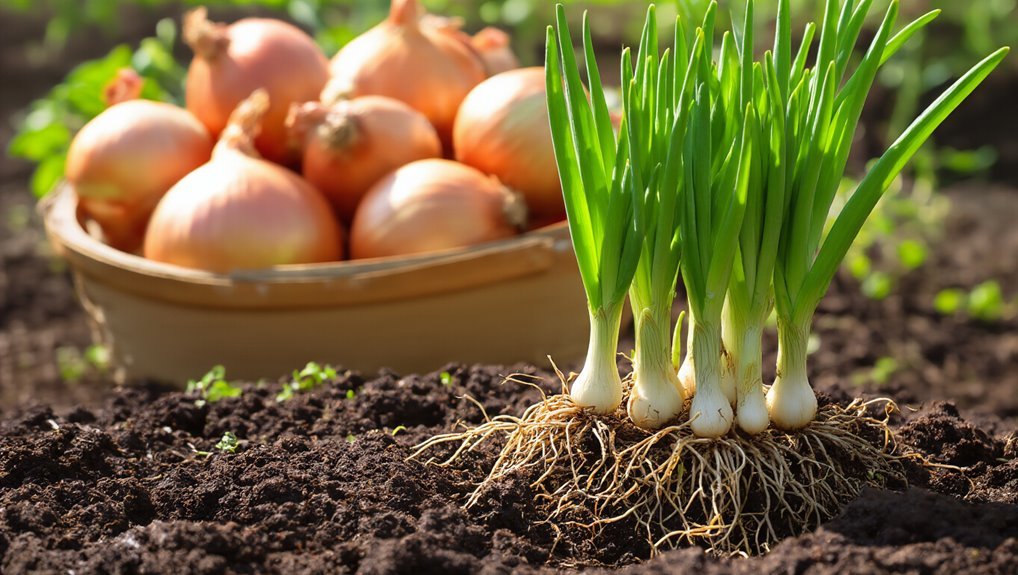
Once your onions have matured, it’s time to harvest them for a delicious addition to your kitchen. Gently pull them from the soil, taking care not to damage the bulbs. If they’re stubborn, use a garden fork to loosen the soil around them.
After pulling them, let your onions dry in a warm, shaded spot for a few days to cure. This process enhances their flavor and shelf-life.
Once cured, trim the roots and remove any damaged outer layers. Store your onions in a cool, dark place, like a pantry, to keep them fresh.
You can slice them for salads, sauté them for stir-fries, or use them in soups. Enjoy the fruits of your labor in countless dishes!
Frequently Asked Questions
Can I Regrow Onions From Store-Bought Green Onions?
Yes, you can regrow store-bought green onions! Just place the root ends in water, ensuring they’re submerged. Keep them in sunlight, change the water regularly, and watch them sprout new green shoots in no time!
How Long Does It Take for Onion Scraps to Regrow?
When you’re eager to see growth, patience is key; onion scraps typically take about 10 to 14 days to regrow. Just keep them in water, and you’ll soon enjoy fresh greens from your kitchen!
Can I Grow Onions in Water Instead of Soil?
Yes, you can grow onions in water instead of soil. Just place the onion roots in a jar of water, ensuring the roots are submerged while the tops remain above. Change the water regularly for best results.
Are There Specific Onion Varieties That Regrow Better?
Did you know that green onions can regrow up to six times faster than bulbing onions? If you’re looking to regrow onions, consider varieties like scallions or shallots; they thrive in regrowth conditions better than others.
What Pests Should I Watch for When Growing Onions?
When growing onions, you should watch for pests like onion flies, thrips, and aphids. They can damage your plants, so regularly inspect your onions and apply natural pest controls to keep them healthy and thriving.
Conclusion
Growing onions from scraps is not only easy but also a rewarding way to maximize your kitchen waste. Imagine slicing up an onion for dinner and tossing the roots in a pot of soil. In just a few weeks, you’re snipping fresh green tops to garnish your meals. You’re not just saving money; you’re enjoying the satisfaction of nurturing your own food. So go ahead, start regrowing those onion scraps, and watch your kitchen turn into a mini garden!
